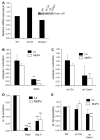Chlamydial infection of monocytes stimulates IL-1beta secretion through activation of the NLRP3 inflammasome
- PMID: 20434582
- PMCID: PMC4074088
- DOI: 10.1016/j.micinf.2010.04.008
Chlamydial infection of monocytes stimulates IL-1beta secretion through activation of the NLRP3 inflammasome
Abstract
Chlamydia trachomatis infections represent the leading cause of bacterial sexually-transmitted disease in the United States and can cause serious tissue damage leading to infertility and ectopic pregnancies in women. Inflammation and hence the innate immune response to chlamydial infection contributes significantly to tissue damage, particularly by secreting proinflammatory cytokines such as interleukin (IL)-1beta from monocytes, macrophages and dendritic cells. Here we demonstrate that C. trachomatis or Chlamydia muridarum infection of a monocytic cell line leads to caspase-1 activation and IL-1beta secretion through a process requiring the NLRP3 inflammasome. Thus, secretion of IL-1beta decreased significantly when cells were depleted of NLRP3 or treated with the anti-inflammatory inhibitors parthenolide or Bay 11-7082, which inhibit inflammasomes and the transcription factor NF-kappaB. As for other infections causing NRLP3 inflammasome assembly, caspase-1 activation in monocytes is triggered by potassium efflux and reactive oxygen species production. However, anti-oxidants inhibited IL-1beta secretion only partially. Atypically for a bacterial infection, caspase-1 activation during chlamydial infection also involves partially the spleen tyrosine kinase (Syk), which is usually associated with a pathogen recognition receptor for fungal pathogens. Secretion of IL-1beta during infection by many bacteria requires both microbial products from the pathogen and an exogenous danger signal, but chlamydial infection provides both the pathogen-associated molecular patterns and danger signals necessary for IL-1beta synthesis and its secretion from human monocytes. Use of inhibitors that target the inflammasome in animals should therefore dampen inflammation during chlamydial infection.
Copyright 2010 Elsevier Masson SAS. All rights reserved.
Figures






Similar articles
-
Guanylate binding proteins enable rapid activation of canonical and noncanonical inflammasomes in Chlamydia-infected macrophages.Infect Immun. 2015 Dec;83(12):4740-9. doi: 10.1128/IAI.00856-15. Epub 2015 Sep 28. Infect Immun. 2015. PMID: 26416908 Free PMC article.
-
Syk kinase signalling couples to the Nlrp3 inflammasome for anti-fungal host defence.Nature. 2009 May 21;459(7245):433-6. doi: 10.1038/nature07965. Epub 2009 Apr 1. Nature. 2009. PMID: 19339971
-
Helicobacter pylori induces IL-1β and IL-18 production in human monocytic cell line through activation of NLRP3 inflammasome via ROS signaling pathway.Pathog Dis. 2015 Jun;73(4):ftu024. doi: 10.1093/femspd/ftu024. Epub 2015 Jan 5. Pathog Dis. 2015. PMID: 25834143
-
SYK kinase signaling and the NLRP3 inflammasome in antifungal immunity.J Mol Med (Berl). 2010 Aug;88(8):745-52. doi: 10.1007/s00109-010-0631-4. Epub 2010 Apr 17. J Mol Med (Berl). 2010. PMID: 20401456 Review.
-
Inflammasomes bridge signaling between pathogen identification and the immune response.Drugs Today (Barc). 2009 Nov;45 Suppl B(Suppl B):105-12. Drugs Today (Barc). 2009. PMID: 20011701 Free PMC article. Review.
Cited by
-
Caspase-11 Contributes to Oviduct Pathology during Genital Chlamydia Infection in Mice.Infect Immun. 2019 Jul 23;87(8):e00262-19. doi: 10.1128/IAI.00262-19. Print 2019 Aug. Infect Immun. 2019. PMID: 31160363 Free PMC article.
-
Subversion of inflammasome activation and pyroptosis by pathogenic bacteria.Front Cell Infect Microbiol. 2013 Nov 26;3:76. doi: 10.3389/fcimb.2013.00076. eCollection 2013. Front Cell Infect Microbiol. 2013. PMID: 24324933 Free PMC article. Review.
-
Cytolethal distending toxin-induced release of interleukin-1β by human macrophages is dependent upon activation of glycogen synthase kinase 3β, spleen tyrosine kinase (Syk) and the noncanonical inflammasome.Cell Microbiol. 2020 Jul;22(7):e13194. doi: 10.1111/cmi.13194. Epub 2020 Mar 4. Cell Microbiol. 2020. PMID: 32068949 Free PMC article.
-
NLRP3 inflammasome activation results in liver inflammation and fibrosis in mice infected with Schistosoma japonicum in a Syk-dependent manner.Sci Rep. 2017 Aug 14;7(1):8120. doi: 10.1038/s41598-017-08689-1. Sci Rep. 2017. PMID: 28808303 Free PMC article.
-
Critical role for NLRP3 in necrotic death triggered by Mycobacterium tuberculosis.Cell Microbiol. 2011 Sep;13(9):1371-84. doi: 10.1111/j.1462-5822.2011.01625.x. Epub 2011 Jul 11. Cell Microbiol. 2011. PMID: 21740493 Free PMC article.
References
-
- Gerbase AC, Rowley JT, Mertens TE. Global epidemiology of sexually transmitted diseases. Lancet. 1998;351:2–4. - PubMed
-
- Miller WC, Ford CA, Morris M, Handcock MS, Schmitz JL, Hobbs MM, Cohen MS, Harris KM, Udry JR. Prevalence of chlamydial and gonococcal infections among young adults in the United States. JAMA. 2004;291:2229–2236. - PubMed
-
- Schachter J. Infection and disease epidemiology. In: Stephens RS, editor. Chlamydia: Intracellular Biology, Pathogenesis, and Immunity. ASM Press; Washington, D.C: 1999. pp. 139–169.
MeSH terms
Substances
Grants and funding
LinkOut - more resources
Full Text Sources
Research Materials
Miscellaneous

